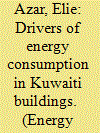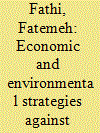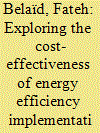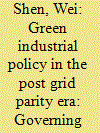|
|
|
Sort Order |
|
|
|
Items / Page
|
|
|
|
|
|
|
| Srl | Item |
| 1 |
ID:
177411


|
|
|
|
|
| Summary/Abstract |
With the world's lowest electrification rate, Africa is repositioning to offer its citizens a brighter future. Global renewable energy agencies and international financing to expedite rural electrification fueled by off-grid solar systems are attracting worldwide attention. Currently, 770 million people lack access to electricity on the continent, and more than 60% live in poor rural areas where the national power grid is non-existent. The challenge herein is how to supply electricity to rural population, living on $1.5 a day, at a reasonable power tariff. Although there are opportunities for off-grid solar energy to keep growing in sub-Saharan countries, it is impossible to ignore particular challenges in these countries. This paper focuses on three sub-Saharan counties: Kenya, Ethiopia, and Rwanda. Rwanda, Kenya, and Ethiopia foster off-grid solar systems as the primary solution through rural electrification programs. This paper provides a comparative analysis of the electrification experiences of these countries in terms of sources of funding, the challenges and opportunities they have been experiencing as well as an analysis of policy implications. The results show that off-grid solar systems improve health, ICT, and micro-enterprises in rural areas. However, governments should generate more robust developmental schemes that provide income to rural people that pushes them above the poverty line and enables them to afford off-grid solar products.
|
|
|
|
|
|
|
|
|
|
|
|
|
|
|
|
| 2 |
ID:
177424


|
|
|
|
|
| Summary/Abstract |
The power sector has tremendous technological potential for decarbonization, hence, the decarbonization of China's power sector is crucial to the successful implementation of national carbon emissions reduction plan. In this study, a decarbonization model with consideration of both technological progress and cross-regional power transmission for China's power sector is built to explore the potential and possible pathway of decarbonization under the constraint of optimal cost. The model is operated at different carbon prices in three economic growth scenarios. Our findings show that the power generation structure is undergoing a shift from coal power to hydropower, nuclear power, and wind power, and both the coal power generation and carbon emissions can peak by 2030. Carbon pricing can speed up this process and reduce the peak height. Additionally, an appropriate carbon price has a significant promoting effect on decarbonization in the power sector; we conclude that the optimal carbon price is 21 USD/t. Moreover, the higher the economic development level, the lower the final average cost of power generation mix and the more significant the carbon emissions reduction, which implies that it is more cost-effective to carry out decarbonization related policy in the power sector during the stage of rapid economic growth.
|
|
|
|
|
|
|
|
|
|
|
|
|
|
|
|
| 3 |
ID:
177406


|
|
|
|
|
| Summary/Abstract |
The COVID-19 pandemic has triggered serious economic crises in many countries. In Spain, millions of individuals have been ordered to remain at home and many are unemployed. The increased use of electrical appliances and low incomes make energy poverty highly likely. This study thus analyses the effectiveness of unemployment benefits and social measures to help Spanish family units pay their electricity bill during the COVID-19-induced lockdown in Spain (March–May 2020) and during a hypothetical lockdown in winter and summer. The results showed that the unemployment aids can contribute to alleviating energy poverty, especially if the unemployed individual worked in a poorly-paying job or for just a few hours. However, the social measures were found insufficient to avoid energy poverty. The application of a variable discount percentage in the electricity bill based on income and the month of the year would reduce energy poverty risk during further incidences of lockdown.
|
|
|
|
|
|
|
|
|
|
|
|
|
|
|
|
| 4 |
ID:
177398


|
|
|
|
|
| Summary/Abstract |
Understanding and quantifying the drivers of energy consumption in buildings is an essential step to identify inefficiencies and guide energy conservation efforts and policies. While such efforts are common in western countries, they remain limited in the Middle East and North Africa (MENA) region, particularly in the State of Kuwait. This article presents the first systematic assessment of the drivers of energy consumption in Kuwaiti commercial and residential buildings. It presents a unique hybrid study approach combining data collected from 463 buildings with Building Performance Simulation (BPS) developed and validated to mimic the performance of archetype (i.e., typical) Kuwaiti buildings. Results identify the built-up area and the thermostat cooling setpoints as the main determinants of electric consumption, quantifying the exact relationships between these variables. For instance, a simple 2 °C increase in the thermostat cooling setpoint can lead to a more than 10% reduction in total energy use. Other parameters that are typically known to affect building performance, such as the type of Air Conditioning (AC) systems installed, did not show statistically significant effects. The findings helped derive important recommendations for the Kuwaiti authorities, covering the educational, technological, and policy-related dimensions of the challenges facing the building sector.
|
|
|
|
|
|
|
|
|
|
|
|
|
|
|
|
| 5 |
ID:
177426


|
|
|
|
|
| Summary/Abstract |
This study sought to investigate the economic-environmental effects of Targeted Subsidy Policy on energy in the meat market of Iran within a game theory framework. The welfare of players in economic game, determined by equilibrium displacement model, and the environmental losses (benefits) from Greenhouse Gas emissions were considered as game payoffs based on the behavior of three players: producers, consumers, and government. Results show an increase in the piece of energy carriers as a policy deterred from enhancing environmental losses and reducing the welfare of each market player. Therefore, eliminating energy subsidy, and redistributing its revenue toward producers to improve technology are regarded as the government's strategy for economic-environmental equilibrium, while removing energy subsidy without repaying is considered as equilibrium strategy in which the effects of Targeted Subsidy Policy are only considered economically or environmentally.
|
|
|
|
|
|
|
|
|
|
|
|
|
|
|
|
| 6 |
ID:
177413


|
|
|
|
|
| Summary/Abstract |
In off-grid electrification, risk assessment often focuses on the economic aspects, which is logical, in terms of financial sustainability, but may not be enough to provide a clearer understanding of the genuine factors involved. Failure to do a comprehensive risk assessment could potentially lead to unsustainable electrification in off-grid areas. This paper intends to elucidate the risks to sustainable electrification of off-grid island communities in the Philippines by expanding the conventional triple bottom line approach of sustainability considering economic, ecological, and social dimensions to include geographical, political, technological, and legal aspects. A G-PESTLE analysis considering 17 indicators is conducted to identify challenges to sustainable electrification from the end-users’ perspective and considering three case islands. Results indicate that risks can vary for each island in terms of the indicators involved. The environmental, legal, and technological factors are common high risks for Pangan-an and Gilutongan while the geographical aspect is a low risk for all three islands. This study serves as a good baseline framework in determining the risks involved in rural electrification in different island communities. Similar studies can be conducted using the same framework to identify the vital elements that lead to developing sustainable electrification initiatives in rural off-grid communities.
|
|
|
|
|
|
|
|
|
|
|
|
|
|
|
|
| 7 |
ID:
177420


|
|
|
|
|
| Summary/Abstract |
The enlargement of the EU towards Central and Eastern Europe started in 2004 and represented a significant challenge for European political and economic agendas. Fifteen years later, Central and Eastern European (CEE) countries have experienced a significant economic growth, mostly based upon industrial development and trade expansion, displaying a strong integration in EU global value chains.
|
|
|
|
|
|
|
|
|
|
|
|
|
|
|
|
| 8 |
ID:
177419


|
|
|
|
|
| Summary/Abstract |
Understanding the impacts of climate change on electricity supply infrastructure (ESI) is important to maintain a reliable power supply. Nonetheless, most existing studies focus on the physical impacts rather than the economic impacts, failing to provide references for the cost-benefit analysis of different abatement policies and measures. With this motivation, this study firstly employs a downscaled climate system model to project temperature paths in the future. Then, an integrated model is established to quantify both physical and economic impacts of long-term future temperature rise on the existing ESI components. Finally, the maximum climate-attributable impacts on China's ESI are assessed for the period from 2018 to 2099. Our major findings are that: (1) 10.2% of the generator ratings, 17.8% of the transmission and distribution line ratings and 10.0% of the transformer ratings are at risk of outage from expected climate change effects. (2) Around $258 billion of the existing ESI assets are at risk of outage due to the future surface temperature rise, representing 14.2% of the ESI assets in 2017. (3) The impacts of climate change on ESI vary substantially among different provinces and among different infrastructure components. These obtained results can provide important guidance for the mitigation and adaption strategies for the climate change impacts on the electricity sector.
|
|
|
|
|
|
|
|
|
|
|
|
|
|
|
|
| 9 |
ID:
177395


|
|
|
|
|
| Summary/Abstract |
The prudent combination of technological, economic, and other factors can enhance the performance of any manufacturing unit. Indian petroleum refineries are no exception to this. In this background, an effort has been made to estimate the gross refining margin using the Fixed Effect and Random Effect Models as well as the Models of White, Rogers, and Driscoll-Kraay standard error Estimators for seven Indian refineries for the period between 2008–09 and 2018–19. The study found that complexity, specific energy consumption, and distillate yield significantly and positively influenced gross refining margin, whereas refinery fuel & loss (loss due to evaporation, flaring, and seepage and chemical losses) and heavy yield significantly and negatively influenced it. The study recommends that Indian refiners should invest more in secondary process units as well as advanced technology to enhance the complexity and distillate yield in order to increase the gross refining margin. They should adopt waste heat recovery, flare gas recovery, and other best operating practices in order to reduce fuel and loss of refinery to increase the gross refining margin. Therefore, policies to optimize the utilization of resources through technological intervention and investment will certainly enhance the gross refining margin of Indian refineries.
|
|
|
|
|
|
|
|
|
|
|
|
|
|
|
|
| 10 |
ID:
177404


|
|
|
|
|
| Summary/Abstract |
Using unique household-level data from rural areas of six energy-access-deprived states in India, we examine the willingness-to-pay (WTP) for exclusive use of liquefied petroleum gas (LPG) for cooking. We find that awareness about LPG's health benefits and diffusion of LPG within the community are the strongest determinants of WTP for exclusive use of LPG. Among demographic characteristics, only household size is correlated with WTP. Importantly, households exhibit significant price elasticity with regards to exclusive use of LPG. Households with irregular cash flows are less likely to pay for exclusive use of LPG. We find limited evidence supporting a negative association between availability of free biomass and the WTP for exclusive use of LPG. In contrast, higher household expenditure on purchased biomass is positively associated with WTP. Our estimates of mean WTP suggest that they are higher than the current effective monthly cost of subsidized LPG across households. However, they mask variation, and disaggregated estimates suggest that about 40–45 per cent of the households not using LPG as their primary fuel have a lower WTP than the current effective monthly cost of subsidized LPG and hence would need additional support to enable their cooking energy transition.
|
|
|
|
|
|
|
|
|
|
|
|
|
|
|
|
| 11 |
ID:
177421


|
|
|
|
|
| Summary/Abstract |
The expansion of renewable energy sources (RES) is a core element used for mitigating carbon emissions in the power sector in many countries. Besides such national measures, the European Union Emission Trade System (EU ETS) limits the carbon emissions and aims at an efficient allocation of the carbon mitigation.
|
|
|
|
|
|
|
|
|
|
|
|
|
|
|
|
| 12 |
ID:
177416


|
|
|
|
|
| Summary/Abstract |
Transformation to sustainability is a worldwide problem to the resource-based cities whose development depends primarily on the exploitation and primary processing of natural resources. Jiaozuo is a typical coal city with a meandering and intriguing development course and a successful transformation example in China. This paper summarizes the experiences and lessons in the growth course of Jiaozuo through calculating the econometric model based on “resource curse” theory and exploring the development process from a historical perspective. It reveals that: Jiaozuo suffers from a certain “resource curse”, especially the “Dutch disease” and “crowding out” effect (the over-reliance on the energy industry leads to the squeezing for science or technology, manufacturing and corruption). The reasons from the rise of Jiaozuo to the successful transformation are the synthesis of resources endowment (high-quality coal and advantageous tourism resources), financial support and technology introduction, seizing transition chance, location advantage, reconstruction of the city image and extensive propaganda. From a long-term perspective, Jiaozuo should take full advantage of the industrial legacies and historical remains expand industry layout and recycling economy. These experiences may provide some references for the sustainable development of other cities and serve as a practical basis for breaking through paths for resources-based cities.
|
|
|
|
|
|
|
|
|
|
|
|
|
|
|
|
| 13 |
ID:
177428


|
|
|
|
|
| Summary/Abstract |
Solar energy applications are crucial to urban sustainable development and energy investment. Among the policies incentivising solar energy utilisation, Feed-in Tariff has been widely applied to stimulate the adoption of solar photovoltaic systems in the residential sector. This paper presents a payback-year-based Feed-in Tariff determination mechanism from the investment perspective, as suggested by recent research survey data. As an important indicator, the time required to recover the investment (i.e., payback year) in a residential PV project is then formulated using the proposed algorithm to determine Feed-in Tariff rates. The proposed mechanism is demonstrated in a case study in Victoria, Australia. Sensitivity analysis is used to identify the optimum Feed-in Tariff ranges for two popular types of rooftop PV systems, i.e., 3 kW and 5 kW, as examples. The results identify the desirable Feed-in Tariff range for individual energy investors as 20.29 A¢/kWh to 28.25 A¢/kWh, and this should be considered as a point of reference in determining the Feed-in Tariff rate in a manner that takes into account end-users’ expectations. The proposed mechanisms and methodology would be useful for policymakers in adjusting Feed-in Tariff incentive policies at a national or regional level.
|
|
|
|
|
|
|
|
|
|
|
|
|
|
|
|
| 14 |
ID:
177394


|
|
|
|
|
| Summary/Abstract |
This research investigates the cost-effectiveness of energy performance measures in French residential buildings. We develop an empirical approach based on a multivariate statistical approach and Cost-Benefit analysis. The strength of this research relies on the designing of a large cross-sectional database collected in 2013 including rich technical information of about 1,400 dwellings representative of the French residential sector as well as individual recommendations relative to the energy renovations to be implemented, their investment costs, and energy savings potential. We provide valuable information on the cost-effectiveness of energy renovation measures for the entire housing stock. Results show that low-temperature and condensing boilers, as well as floor insulation, are the most cost-effective energy efficiency measures, which could be inconsistent with actual subsidy policies. We demonstrate that the cost-effectiveness of energy renovation measures is widely dependent on dwelling initial characteristics and the value of the inputs used in the economic indicators such as energy-savings amount, energy price, and the discount rate. Moreover, we provide a classification of French dwellings, which may help policymakers, better identify their target. Finally, we show that the renovation of the entire French residential dwelling stock can lead to a great amount of energy–and CO2–reductions but requires significant financial capacity.
|
|
|
|
|
|
|
|
|
|
|
|
|
|
|
|
| 15 |
ID:
177415


|
|
|
|
|
| Summary/Abstract |
This paper presents an analytical framework to study the spatial distribution of the labor impacts of clean energy transitions. While there exists optimism about the job creation potential of clean energy industries, just transitions literature has emphasized that the costs and benefits of energy transitions will not be distributed equally. Aggregate labor estimates hide the regional inequalities that might surface sub-nationally.
|
|
|
|
|
|
|
|
|
|
|
|
|
|
|
|
| 16 |
ID:
177401


|
|
|
|
|
| Summary/Abstract |
Electricity suppliers in many countries are legally required to disclose their electricity products' fuel mix, with the objective of helping consumers make more informed electricity purchase decisions. The fuel mix disclosure system in Germany differs from those of many other countries and from that which the European Union demands. While electricity suppliers must list fossil and fissile energy sources individually, the renewable energy sources (RES) are lumped together under the generic terms “renewable energies supported by the EEG” and “other renewable energies.” We investigated whether breaking these generic terms down into their components (photovoltaics, hydropower, wind power, and biomass) impacts consumers' preferences and their willingness to pay for renewables. Our results suggest that consumers are willing to pay more for electricity made from RES when information about the individual RES was provided. We found that a possible explanation for this finding is that consumers perceive the specified RES as less harmful to the environment than the two generic RES and that consumers have poor knowledge about what energy sources these generic RES represent. We therefore recommend German policy makers to move away from the current fuel mix disclosure system toward one that provides more detailed information.
|
|
|
|
|
|
|
|
|
|
|
|
|
|
|
|
| 17 |
ID:
177422


|
|
|
|
|
| Summary/Abstract |
Most households in sub-Saharan Africa rely on wood-based cooking fuels and their number is expected to rise. Despite this, national and subnational energy policies often neglect biomass cooking fuels. A Formative Scenario Analysis process is applied to show how the cooking fuel sector in Kilimanjaro Region (Tanzania) and Kitui County (Kenya) might evolve by 2030. In order to provide relevant knowledge for potential energy policies, this paper aims to identify the main drivers impacting the cooking fuel sector, and to assess and explore current and future demand and supply potential of biomass cooking fuels.
|
|
|
|
|
|
|
|
|
|
|
|
|
|
|
|
| 18 |
ID:
177418


|
|
|
|
|
| Summary/Abstract |
China has entered the age of grid-parity for solar PV technologies, which impose significant challenges for the Chinese government to continue its support on this fast growing sector. The traditional rationale and design of many green industrial policies (GIPs) in the renewable energy sector, such as the multi-tiered feed-in tariff system introduced at earlier stage, has become increasingly inefficient. New policy approaches are needed. We use a case study of Integrated Solar Energy and Desertification Prevention (ISE-DP) initiative in China's Inner Mongolia region to investigate the potential of providing further support for the solar PV industry on the basis of the accrued development benefit, such as ecological restoration, agricultural outputs, and local employment.
|
|
|
|
|
|
|
|
|
|
|
|
|
|
|
|
| 19 |
ID:
177405


|
|
|
|
|
| Summary/Abstract |
Nuclear energy is an important consideration for decarbonisation. However, for Singapore – a country at the nascent stage of nuclear energy development – the building of a nuclear research reactor could be a precursor to a full-fledged nuclear energy plan. Guided by the cognitive miser model and the knowledge deficit model, this study examines factors shaping public support for the use of a nuclear research reactor for medical purposes. In particular, we seek to understand how different types of knowledge could affect public support for the use of a nuclear research reactor in an island city-state. Based on the data from a nationally representative door-to-door survey of 1000 adult Singaporeans, we found that the public mainly depend on heuristics, such as religiosity, benefit perception, and trust in relevant authorities, to form attitudes towards the use of a nuclear research reactor, revealing a tendency to employ mental shortcuts for decision making. More importantly, we found that heuristics moderated the effect of contextual nuclear knowledge on public support for the use of a nuclear research reactor. This indicates that individuals might interpret the same information differently, depending on their firmly held beliefs or pre-existing perceptions.
|
|
|
|
|
|
|
|
|
|
|
|
|
|
|
|
| 20 |
ID:
177409


|
|
|
|
|
| Summary/Abstract |
Energy efficiency in the home is a major concern for households, governments and various non-government organisations. Energy efficiency has implications beyond usage and costs, with various co-benefit outcomes such as improved household health and well-being, comfort, air quality, increased productivity, energy security and improved social capital. The purpose of this systematic literature review is to examine energy efficiency interventions in advanced economies focusing on the household and determine the level of evidence regarding their effectiveness. We broadly scrutinise literature from 1990 to November 2019 to determine how theory and frameworks are used (or not used) to inform household interventions, the populations or groups of focus, which techniques and activities are used, and how outcomes are measured. We find mixed evidence to support specific types of interventions; however, when multiple techniques and activities were used, the intervention's success was more likely. We conclude with policy implications that call for more integrated and methodical explanations of interventions to better support critical decision-making for government.
|
|
|
|
|
|
|
|
|
|
|
|
|
|
|
|
|
|
|
|
|